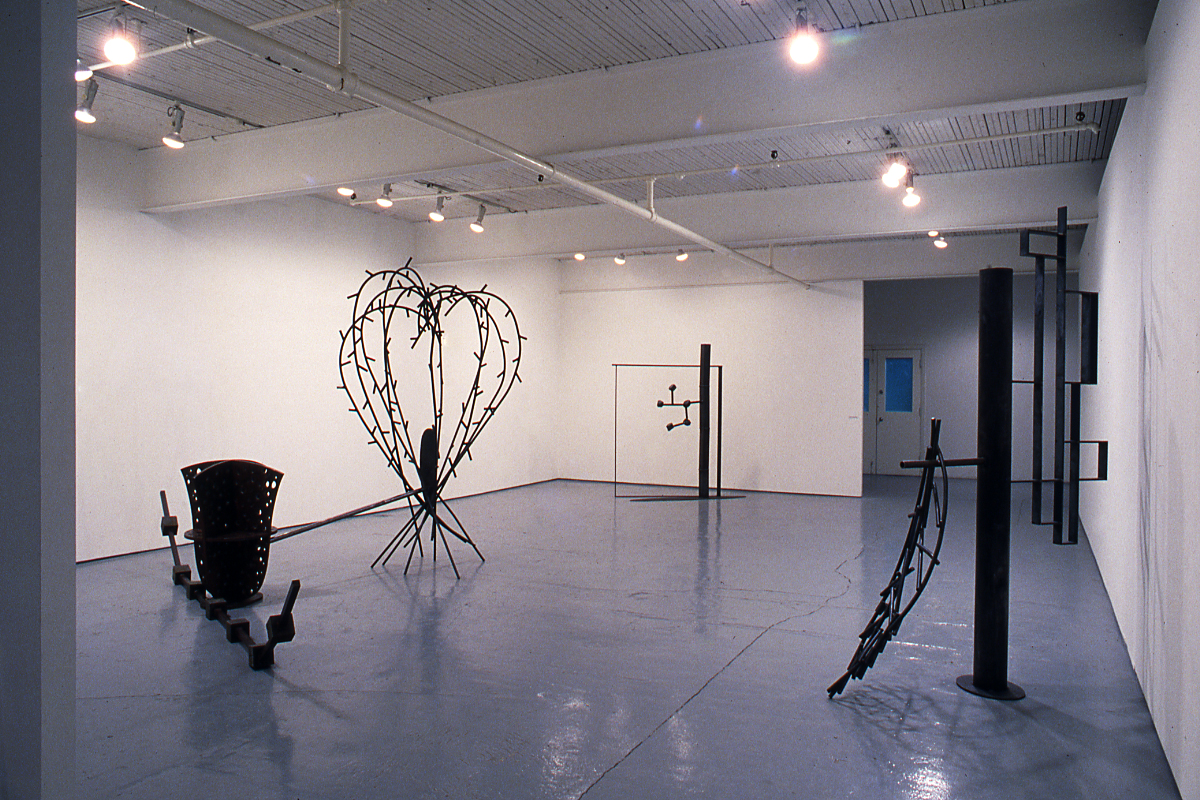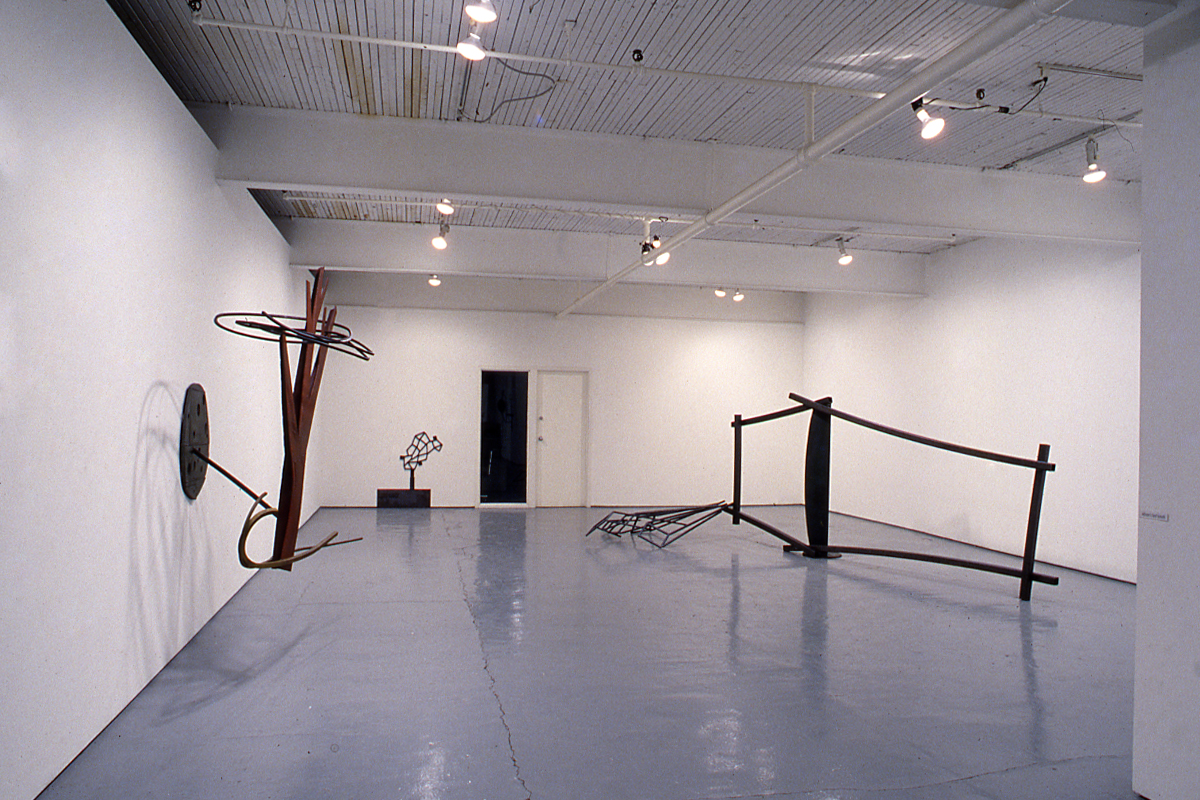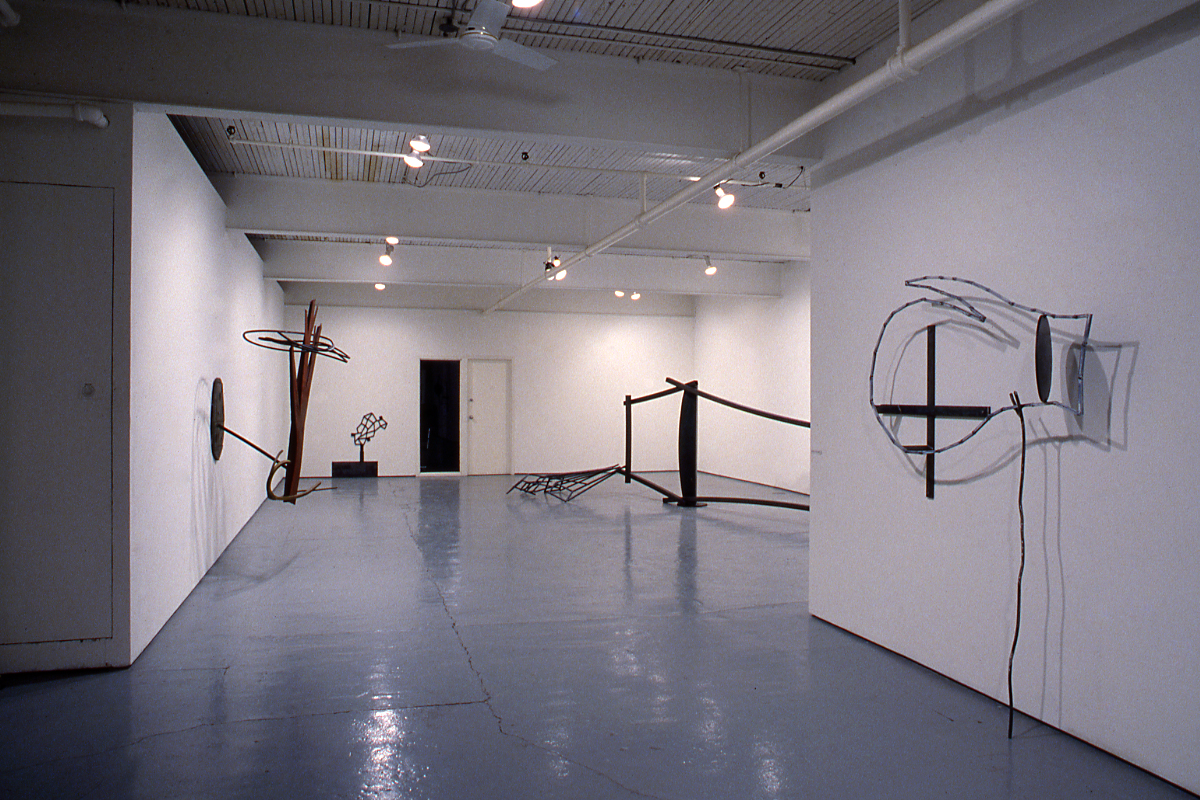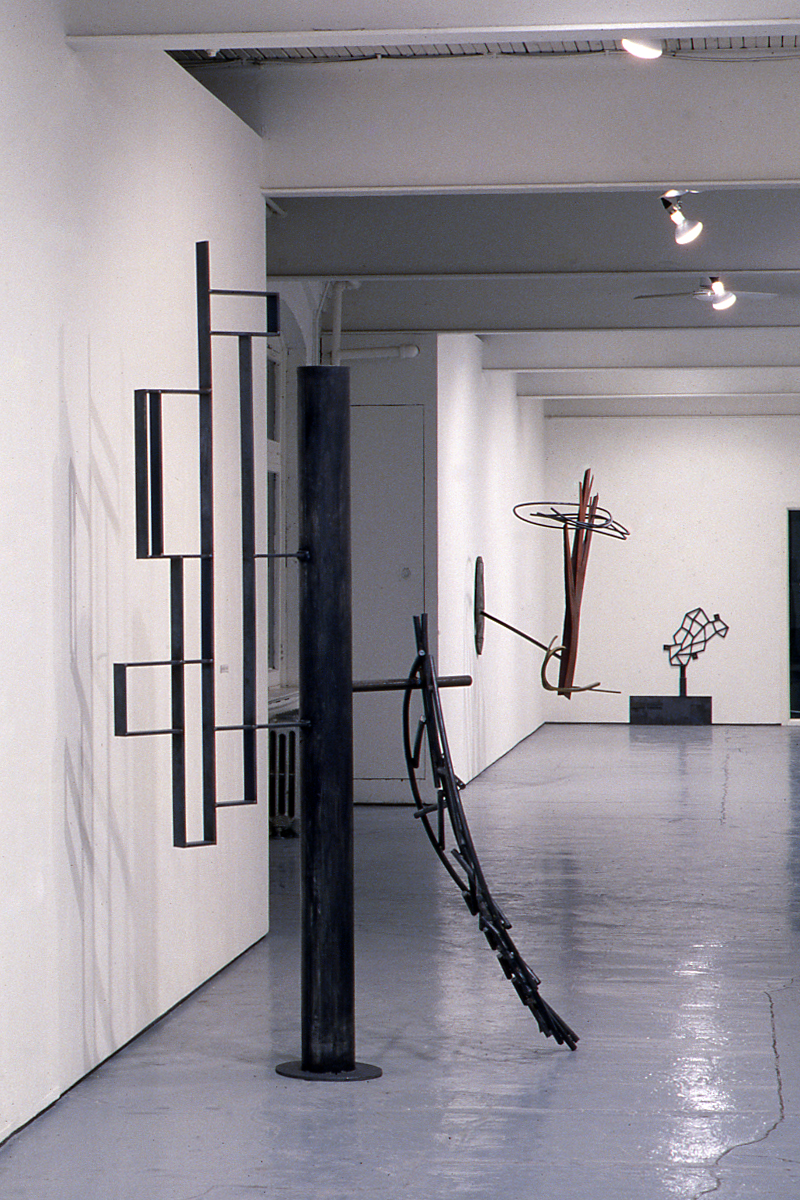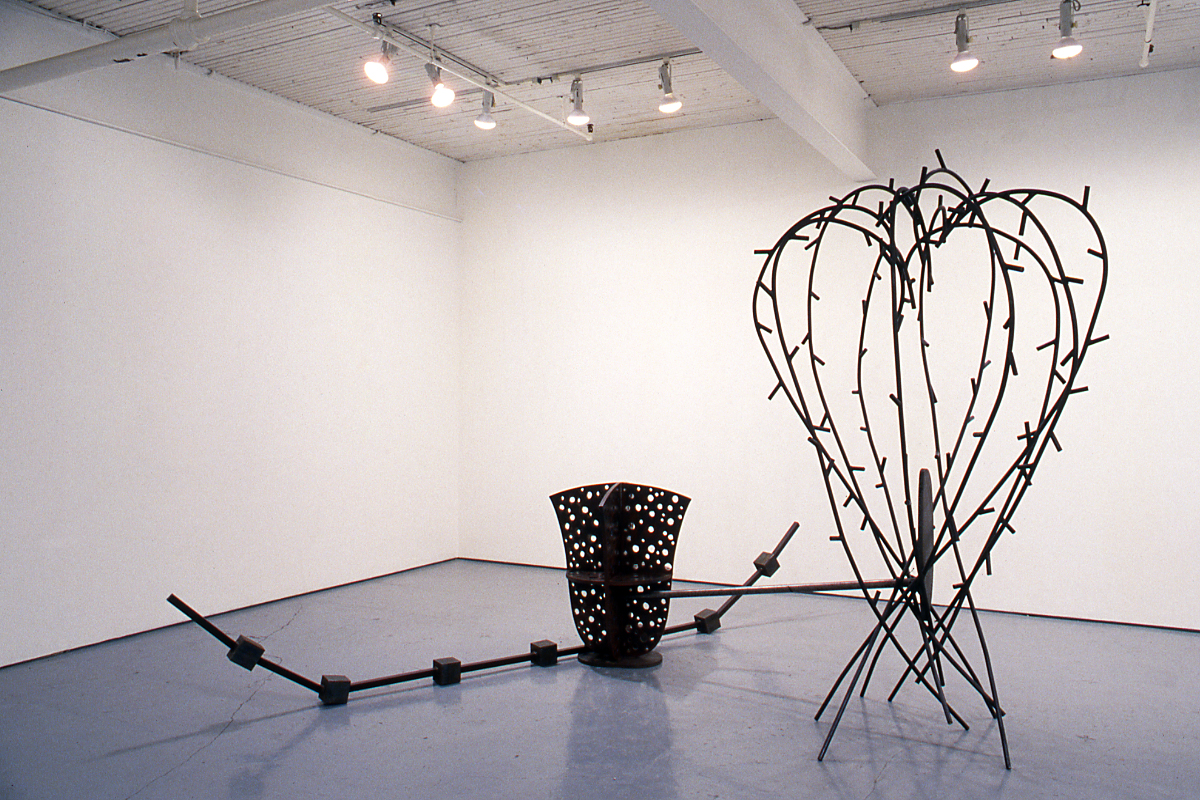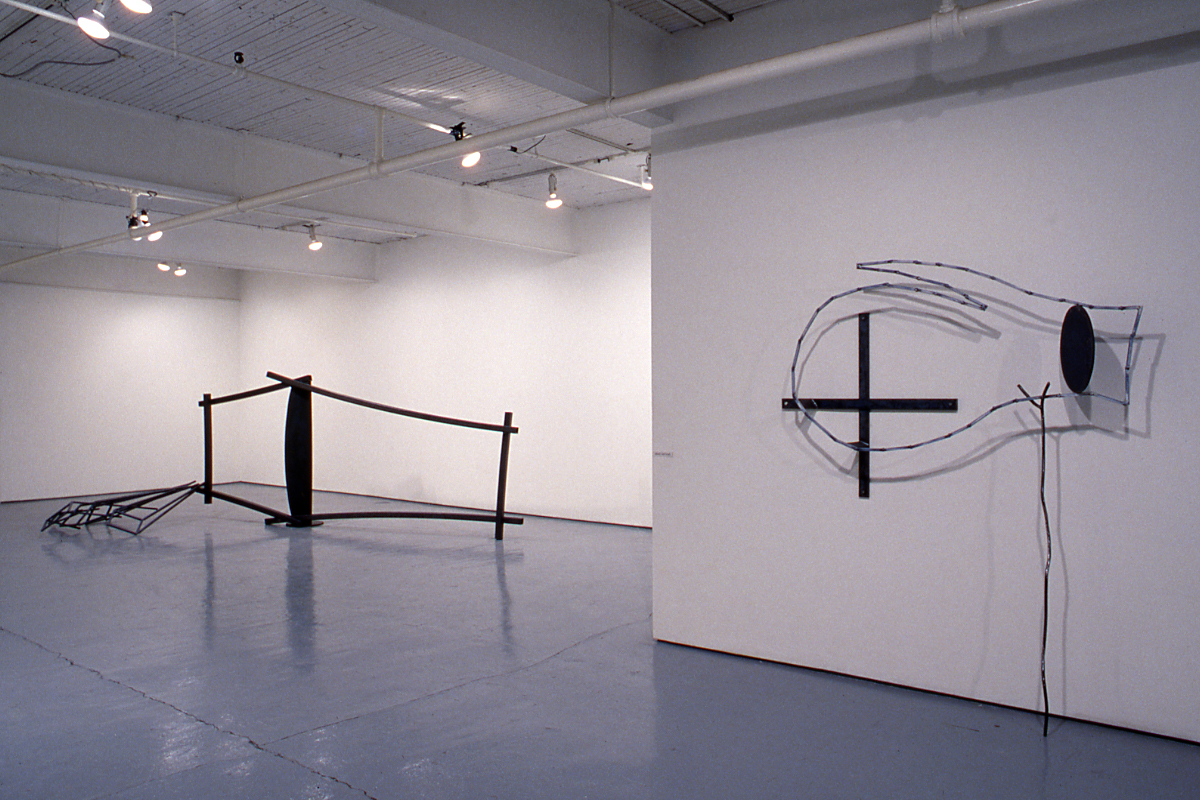East and West Galleries:
Opening Thursday March 15 at 8:00 pm and continuing through to April 14, Mercer Union presents a major solo exhibition of works by Toronto sculptor John McKinnon. This exhibition, in both gallery spaces, offers Toronto audiences an opportunity to view an extensive selection of the artist' s new sculptures in conjunction with a number of previous works.
Working with standard issue mild stock steel, bar, plate and tube, McKinnon creates works that resist the massiveness often associated with these materials. Instead, his works are characterized by a 'structural/skeletal' quality, retaining the leanness and linear quality of a sketch.
McKinnon strives to present the viewer with a belief system. He employs a visual narrative, often culminating in an event, a moment or an affective state, within the structure of the narrative, pointing to a larger subsequent history. Through his cryptographic notations, he gives concrete form to abstract representations, moving freely back and forth between ontological, physical and cosmological dimensions.
The exhibition will be accompanied by a catalogue which will include essays by Toronto writer and curator Ihor Holubizky and Toronto artist Bernie Miller.
--all of these were historically infused with an agglomeration of self-sufficiency, communitarianism, localized popular culture, thrift and subjective social bonds and experiences that stood, like Indians on the frontiers of industrial cultural development. It was those subjective experiences of traditional culture that stood between the advancing industrial machinery and the synthesis of a new order of industrial culture. And it was incumbent on industry in formalizing the new order to find a means to sacrifice the old. 5
This was the historical circumstance in which culture as we now know it, including mass culture, was formed. So the view of traditional practices whether intended or not was seen, historically, by the creators of our mass culture as pockets of resistance. Given this then, I would suggest that all art practices have this potential for resistance to the commodity nexus, if commodity is here understood as that made object which stands in a peculiar ideological relation to its origins in human endeavour.
John McKinnon's long-time use of welded steel is party to a dilemma whether consciously or not. To walk into a studio where an artist does his own welding is to walk into a workplace where the work is organized as if Henry Ford had never lived. In such a studio the air is thick with connotations of the artisan, the atelier, the craftsman-apprentice system; one thinks of metallurgy, vulcanism, the basic elements. Scientific management? Hah! True, there are escapist seductions to such practices. But just as there is a denial of the outside corporate world here, there is something in these made objects that the corporate commodity has gone to great effort to deny--their source in human effort.
McKinnon's sculpture is very clearly worked, one might say to some extent it appears wrought. The plasticity of the steel is in high evidence. Elements are often bent, marked up and flame carved before they are welded together in an articulate readable ensemble. His insistence on treating steel as a medium in which to draw, rather than treating it as the materials of massive support structures, emphasizes this wrought character. Somehow one is not burdened by a labour that is intensive, nor is the character of the work heroic as in a struggle with inert mass. It seems often, quite the opposite: skeletal, even alien, often vulnerable.
This very 'made' character of the work in a direct way counters those aspects which are ideologically suspended in the commodity form. Is it not possible then, that this relation to work, the body, the senses be seen as an equally suitable site of resistance to the corporate organization of human endeavour? Equal, that is, to the more obvious forms of critique.
1. Stuart Ewen, Captains of Consciousness ~New York: MacGraw Hill Book Company, 19761, p. 55-56.
All quotes in this essay are taken from this text.
2. Ibid, p. 106. Ewen quotes Samuel Haber from Efficiency and Uplift, as quoted in "The Origins of Job Structure in the Steel Industry" by Kathy Stone, Radical America, vol.7, no.6 "Nov-Dec 1973".
3. Ibid, p. 105. Ewen quotes from Mythologies by Roland Barthes, 1972.
4. Ibid, p. 203.
5. Ibid, p. 58.
Bernie Miller is a Toronto based artist.
John McKinnon
by Earl Miller
AZURE, May 1990
John McKinnon's recent exhibition at Mercer Union (March 15-April 14) was a mini retrospective of sculptures produced since l986. McKinnon, avoiding philosophizing and emotive expressionism, presented sculpture that is unapologetically concerned with pure form. Potential narratives and symbolic images are inferred but ultimately it is the visual impact of sculpture that is the essence of his art.
What is most striking about McKinnon's sculpture is the dense, linear configurations of steel rods and bars that characterize his work. Despite the thinness of the steel the sculptures are fluid; like quick, spontaneous line drawings. Roughly hewn and unfinished in appearance, they are wrought, paradoxically, into delicate, elegant forms.
McKinnon is fascinated by the basic, pared down structure of objects. Take, for instance, 'postures before a shadow' (1989), where he has divided, by means of a vertical steel rod, a skeletal outline of a leaf and a rigid geometric grid that is distinctively architectonic in nature. These imaginative forms, however, do not provide commentary on the subjects they depict. The piece instead functions as an all encompassing image that is completely captivating in itself.
Outstanding in the exhibition is 'Plan of a coal mine' 1990, a piece whose strength lies in its vibrant variety of visual contradiction. An airy rectangular structure, constructed of sharp, lean, vertical lines is contrasted with the bulkiness of squarish, geological forms, apparently coal. The piece carries a number of allusions to nature, the elements and the earth, but McKinnon does not provide any definitive narrative, leaving the interpretation of the piece to the imagination of the viewer.
There is something about these sculptures, their unruly ruggedness perhaps, that makes them appear out of place when installed within the white walls of an art gallery. It would seem much more fitting to display them outdoors, like the several public sculpture commissions McKinnon has already been awarded. He has received two particularly prestigious commissions: one for the completion of a decorative fence for Copperfield, a new housing complex in North Toronto, the other for an installation produced in collaboration with Brian Kipping, for the entrance to the councilor's office in City Hall.
McKinnon, certainly an eclectic artist, has also ventured into the territory of design, producing one-of-a-kind furniture which shares the graceful form of his sculpture. John McKinnon simplifies sculpture to a state where the pure beauty of fundamental form is given preference over possible meaning. But it is more than worthwhile to explore the complexity that McKinnon has discovered lying within the structure of things.
